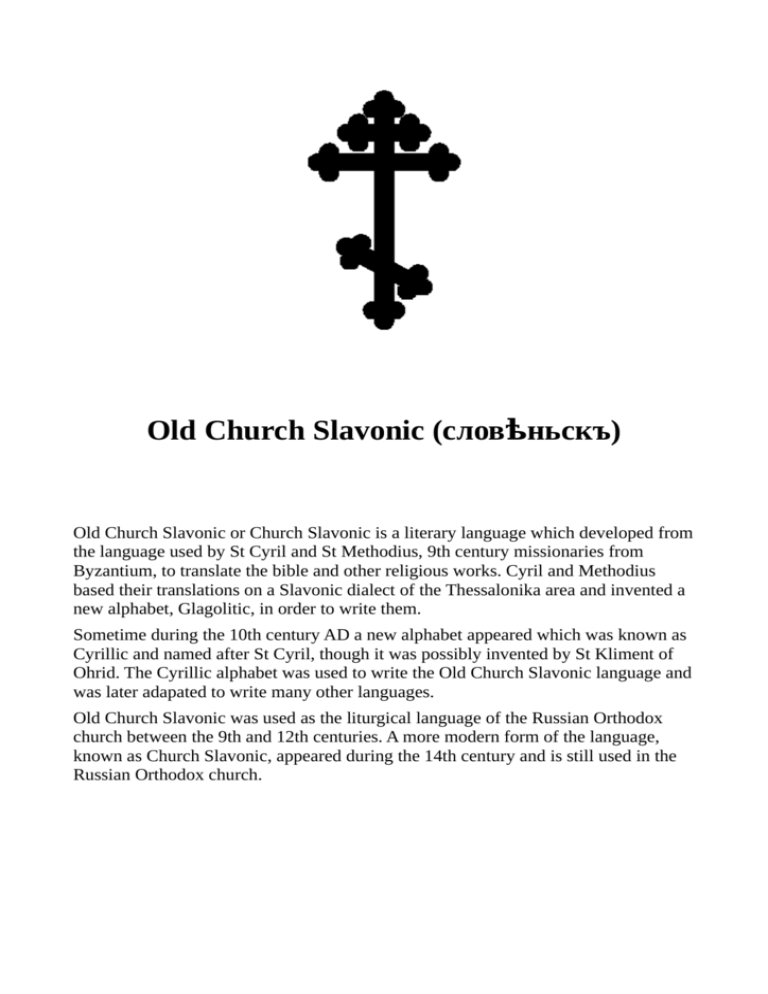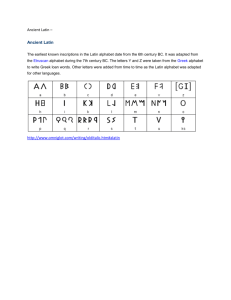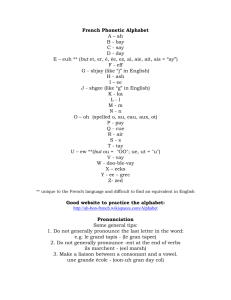Old Church Slavonic (слов ньскъ) ѣ
advertisement

Old Church Slavonic (словѣньскъ) Old Church Slavonic or Church Slavonic is a literary language which developed from the language used by St Cyril and St Methodius, 9th century missionaries from Byzantium, to translate the bible and other religious works. Cyril and Methodius based their translations on a Slavonic dialect of the Thessalonika area and invented a new alphabet, Glagolitic, in order to write them. Sometime during the 10th century AD a new alphabet appeared which was known as Cyrillic and named after St Cyril, though it was possibly invented by St Kliment of Ohrid. The Cyrillic alphabet was used to write the Old Church Slavonic language and was later adapated to write many other languages. Old Church Slavonic was used as the liturgical language of the Russian Orthodox church between the 9th and 12th centuries. A more modern form of the language, known as Church Slavonic, appeared during the 14th century and is still used in the Russian Orthodox church. Early Cyrillic alphabet used for Old Church Slavonic Sample text in Old Church Slavonic 1. 2. 3. 4. въ оно врѣмѧ изідє заповѣдь отъ кєсарѣ авгоста напісаті вс҄ ѫ вьсєлєнѫѭ | сє напісаніє пръвоє бъістъ владѫщѹ сѹрієѭ и кѵрінієѭ | и идѣахѫ вьсі напісатъ сѧ кьждо въ свои градъ | вьзідє жє иосіфь отъ галілєѧ и града назарєтьска вь июдєѭ вь градъ давъідовъ іжє наріцаєтъ сѧ віѳлєємь занє бѣашє отъ домѹ и отьчьствіѣ давъідова | Translation 1. And it came to pass in those days, that there went out a decree from Caesar Augustus, that all the world should be taxed. 2. (And this taxing was first made when Cyrenius was governor of Syria.) 3. And all went to be taxed, every one into his own city. 4. And Joseph also went up from Galilee, out of the city of Nazareth, into Judaea, unto the city of David, which is called Bethlehem; (because he was of the house and lineage of David:) Luke 2: 1-4 Glagolitic alphabet Origin The Glagolitic alphabet was invented during the 9th century by the missionaries St Cyril (827-869 AD) and St Methodius (826-885 AD) in order to translate the Bible and other religious works into the language of the Great Moravia region. They probably modelled Glagolitic on a cursive form of the Greek alphabet, and based their translations on a Slavic dialect of the Thessalonika area, which formed the basis of the literary standard known as Old Church Slavonic. Old Church Slavonic was used as the liturgical language of the Russian Orthodox church between the 9th and 12th centuries. A more modern form of the language, known as Church Slavonic, appeared during the 14th century and is still used in the Russian Orthodox church. Glagolitic alphabet Cursive version of the Glagolitic alphabet Greek alphabet (Ελληνικό αλφάβητο) Origin The Greek alphabet has been in continuous use for the past 2,750 years or so since about 750 BC. It was developed from the Canaanite/Phoenician alphabet and the order and names of the letters are derived from Phoenician. The original Canaanite meanings of the letter names was lost when the alphabet was adapted for Greek. For example, alpha comes for the Canaanite aleph (ox) and beta from beth (house). At first, there were a number of different versions of the alphabet used in various different Greek cities. These local alphabets, known as epichoric, can be divided into three groups: green, blue and red. The blue group developed into the modern Greek alphabet, while the red group developed into the Etruscan alphabet, other alphabets of ancient Italy and eventually the Latin alphabet. By the early 4th century BC, the epichoric alphabets were replaced by the eastern Ionic alphabet. The capital letters of the modern Greek alphabet are almost identical to those of the Ionic alphabet. The minuscule or lower case letters first appeared sometime after 800 AD and developed from the Byzantine minuscule script, which developed from cursive writing. Notable features • Type of writing system: alphabet - the first one to include vowels. • Direction of writing: Originally written horizontal lines either from right to left or alternating from right to left and left to right (boustrophedon/βουστροφηδόν). Around 500 BC the direction of writing changed to horizontal lines running from left to right. • Diacritics to represent stress and breathings were added to the alphabet in around 200 BC. In 1982 the diacritics representing breathings, which were not widely used after 1976, were officially abolished by presidential decree. • The letter sigma has a special form which is used when it appears at the end of a word. Used to write Greek (Ελληνικά), an Indo-European language spoken by about 14 million people mainly in Greece and Cyprus, where it is an official language. Greek is also recognised as a minority language in parts of Turkey, Italy and Albania. Today the Greek alphabet is used only to write Greek, however at various times in the past it has been used to write such languages as Lydian, Phrygian, Thracian, Gaulish, Hebrew, Arabic, Old Ossetic, Albanian, Turkish, Aromanian, Gagauz, Surguch and Urum. Ancient Greek alphabet This alphabet is based on inscriptions from Crete dated to about 800 BC. Greek was written from right to left in horizontal lines at this time. The names of the letters were slightly different to those for later varities Greek. Greek alphabet (Classical Attic pronunciation) Note • Σ = [z] before voiced consonants Obsolete and archaic letters Greek numbers The Ancient Greeks assigned numerical values to the letters of their alphabet to represent numbers. Three obsolete letters, stigma, koppa and sampi were used in addition to the standard Greek letters. Greek alphabet (Modern pronunciation) Sample text in Greek Transliteration Óli i ánthropi yeniúnde eléftheri ke ísi stin aksioprépia ke ta dhikeómata. Íne prikizméni me loyikí ke sinídhisi, ke ofílun na simberiféronde metaksí tus me pnévma adhelfosínis. Sample text in Polytonic Greek Translation All human beings are born free and equal in dignity and rights. They are endowed with reason and conscience and should act towards one another in a spirit of brotherhood. (Article 1 of the Universal Declaration of Human Rights) Source: http://www.omniglot.com/writing/ocslavonic.htm www.prophet-elias.com









